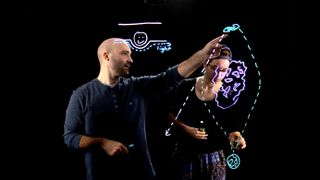'We Don't Planet' Episode 3: What's Up with Gravitational Lensing?

The fundamental description of gravity under general relativity — that the presence of matter and energy deforms the fabric of space-time, and this deformation influences the motion of other objects — leads to a rather unexpected result: a massive object can act like a lens, magnifying and warping the images of background objects.
This prediction was the first major test of general relativity, with Sir Arthur Eddington leading an expedition to measure the small (but detectable) deflection of starlight around our sun, and today this facet of our universe is used as a powerful cosmological probe.
The challenge that gravitational lensing answers is the determination of mass at very large scales. Since most of the mass of the universe is composed of dark matter, we can only rely on indirect probes to measure the true mass of galaxies and clusters of galaxies. Since gravitational lensing works with any kind of matter (dark or luminous or otherwise), we can use the distortion of images of background galaxies to directly measure mass, giving us a completely independent probe of dark matter.
We can even go one step further: by combining multiple lensed images in and around a massive object, we can probe the interior distribution of matter. So not only can we measure total mass, but rather accurately determine where the matter is located in an extended structure.
"We Don’t Planet" is hosted by Ohio State University astrophysicist and COSI chief scientist Paul Sutterwith undergraduate student Anna Voelker. Produced by Doug Dangler, ASC Technology Services. Supported by The Ohio State University Department of Astronomyand Center for Cosmology and AstroParticle Physics. You can follow Paul on Twitterand Facebook.
Get the Space.com Newsletter
Breaking space news, the latest updates on rocket launches, skywatching events and more!
Join our Space Forums to keep talking space on the latest missions, night sky and more! And if you have a news tip, correction or comment, let us know at: community@space.com.

Paul M. Sutter is an astrophysicist at SUNY Stony Brook and the Flatiron Institute in New York City. Paul received his PhD in Physics from the University of Illinois at Urbana-Champaign in 2011, and spent three years at the Paris Institute of Astrophysics, followed by a research fellowship in Trieste, Italy, His research focuses on many diverse topics, from the emptiest regions of the universe to the earliest moments of the Big Bang to the hunt for the first stars. As an "Agent to the Stars," Paul has passionately engaged the public in science outreach for several years. He is the host of the popular "Ask a Spaceman!" podcast, author of "Your Place in the Universe" and "How to Die in Space" and he frequently appears on TV — including on The Weather Channel, for which he serves as Official Space Specialist.
Most Popular

